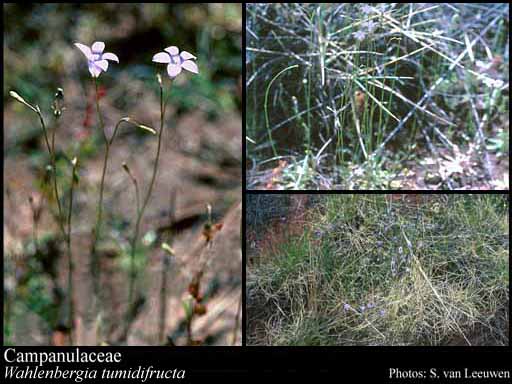- Reference
- Gen.Pl. [Jussieu] 163 (1789)
- Name Status
- Current

Scientific Description
Common name. Bellflower Family.
Habit and leaf form. Herbs (mostly), or trees to shrubs (a few); laticiferous. The herbs mostly perennial; plants with a basal concentration of leaves, or with neither basal nor terminal concentrations of leaves. The trees pachycaul. Hydrophytic to xerophytic; when hydrophytic, rooted. Leaves of hydrophytes submerged and emergent; usually alternate, or opposite (sometimes), or whorled (sometimes); petiolate, or subsessile; sheathing, or non-sheathing. Leaf sheaths with free margins. Leaves not gland-dotted; simple (usually), or compound (occasionally); epulvinate; when compound, pinnate. Leaf blades when simple, dissected, or entire; linear to orbicular; when simple-dissected, pinnatifid, or palmately lobed. Leaves without stipules. Leaf blade margins commonly crenate, or serrate, or dentate. Leaves without a persistent basal meristem. Leaf anatomy. Hydathodes very commonly present. Stem anatomy. Nodes unilacunar. Secondary thickening developing from a conventional cambial ring.
Reproductive type, pollination. Fertile flowers hermaphrodite. Unisexual flowers absent. Plants hermaphrodite. Entomophilous. Pollination mechanism conspicuously specialized (involving stylar tissue extended to cover the stigma at anthesis, the presentation mechanism active in most Lobelioideae but passive in Campanuloideae).
Inflorescence and flower features. Flowers solitary, or aggregated in ‘inflorescences’; in cymes, in racemes, in spikes, and in umbels. The terminal inflorescence unit cymose, or racemose. Inflorescences scapiflorous, or not scapiflorous; terminal, or axillary; with involucral bracts, or without involucral bracts; pseudanthial, or not pseudanthial. Flowers medium-sized to large; regular to somewhat irregular; 5 merous; cyclic; tetracyclic. Perianth with distinct calyx and corolla; 10; 2 -whorled; isomerous. Calyx 5; 1 -whorled; polysepalous, or gamosepalous (depending on interpretation — the ‘tube’ nearly always being united with the ovary); imbricate, or valvate; basally appendaged (e.g. in Campanula, with adjoining pairs of sepals contributing to each appendage), or neither appendaged nor spurred. Epicalyx present (sometimes), or absent. Corolla 5; 1 -whorled; gamopetalous (commonly), or polypetalous (e.g. Jasione); valvate; often campanulate; bilabiate, or regular; blue (predominantly), or white, or yellow, or red, or pink, or purple. Androecium 5. Androecial members free of the perianth, or adnate (then low down on the corolla); free of one another, or coherent; 1 -whorled. Androecium exclusively of fertile stamens. Stamens 5; isomerous with the perianth; oppositisepalous; all alternating with the corolla members. Anthers cohering, or separate from one another; dehiscing via longitudinal slits; introrse; tetrasporangiate. Gynoecium 2 carpelled, or 3 carpelled, or 5 carpelled. The pistil 2 celled, or 3 celled, or 5(–10) celled. Gynoecium syncarpous; synstylovarious; inferior (usually), or superior (rarely). Ovary plurilocular; 2 locular, or 3 locular, or 5(–10) locular. Locules secondarily divided by ‘false septa’ (sometimes?), or without ‘false septa’ (usually). Styles 1. Stigmas 2, or 3, or 5 (as many as the carpels); wet type, or dry type; papillate, or non-papillate; Group II type and Group IV type. Placentation axile. Ovules 10–50 per locule (i.e. ‘many’); horizontal; non-arillate; anatropous.
Fruit and seed features. Fruit fleshy (rarely), or non-fleshy (nearly always); dehiscent, or indehiscent; a capsule (usually), or a berry. Capsules septicidal, or loculicidal, or valvular, or splitting irregularly (i.e. variously dehiscent). Seeds endospermic. Endosperm oily (rarely starchy). Seeds small; winged, or wingless; with starch (rarely), or without starch. Cotyledons 2. Embryo achlorophyllous (4/6); straight. Seedling. Germination phanerocotylar.
Physiology, biochemistry. Aluminium accumulation not found. Photosynthetic pathway: C3.
Geography, cytology, number of species. Holarctic, Paleotropical, Neotropical, Cape, Australian, and Antarctic. World distribution: cosmopolitan, except tropical Africa. X = 6–17. 2000 species.
Economic uses, etc. Numerous ornamentals from Lobelia, Wahlenbergia, Codonopsis, Jasione, etc., and more than 120 species of Campanula.